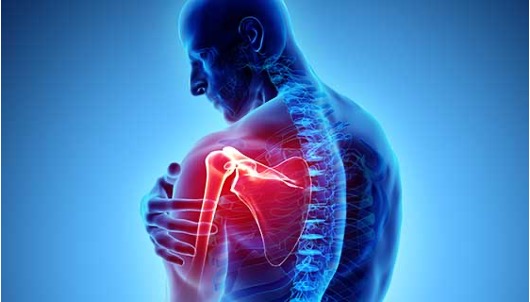The shoulder is the most mobile joint in the body, allowing us to lift, reach, and rotate freely. But with that mobility comes vulnerability. Shoulder injuries are among the most common musculoskeletal problems, affecting athletes, office workers, and seniors alike. This blog breaks down the causes, symptoms, and recovery options so you can better understand and manage shoulder pain.
Common Causes of Shoulder Injuries:
The shoulder is one of the most flexible joints in the human body, but that freedom of movement also makes it vulnerable. Shoulder injuries affect people of all ages — from athletes and laborers to office workers and seniors.
1. Overuse and Repetitive Movements
Sports like swimming, baseball, tennis, and weightlifting often require repeated overhead motions. Over time, these movements can strain the rotator cuff tendons, leading to tendinitis, tears, or impingement syndrome. Even non-athletic repetitive activities, such as painting or assembly-line work, can cause overuse injuries.
2. Poor Posture and Muscle Imbalance
Long hours at a desk, hunching over devices, or slouching can weaken postural muscles and place extra strain on the shoulders. Over time, this imbalance increases the risk of shoulder pain, stiffness, and chronic injury.
3. Traumatic Incidents
A fall, heavy lifting accident, or sudden impact (like during sports or car accidents) can cause dislocations, fractures, or severe soft tissue tears. These injuries often appear suddenly and may require urgent medical care.
4. Aging and Degeneration
As we age, tendons lose elasticity and strength. This natural wear and tear makes the shoulder more prone to rotator cuff tears, arthritis, or “frozen shoulder.” Degenerative changes often develop gradually but can significantly limit daily activities.
5. Structural Problems
Bone spurs or variations in shoulder anatomy can cause friction against tendons, leading to irritation or tearing. Conditions like shoulder impingement are often linked to these structural factors.
6. Lack of Conditioning
Weak shoulder and upper back muscles reduce joint stability. Without adequate strength and flexibility, the shoulder is more susceptible to injury during sports, workouts, or even everyday tasks.
Symptoms of Shoulder Injuries:
The shoulder is one of the most mobile joints in the body, which also makes it prone to injury. Recognizing the symptoms early can help prevent minor issues from becoming serious conditions. Whether caused by sports, work strain, or age-related changes, shoulder injuries often share telltale signs.
1. Pain
- Dull ache or sharp pain in the shoulder or upper arm.
- Pain that worsens with overhead activities, lifting, or reaching behind the back.
- Night pain, especially when lying on the affected side, is common with rotator cuff problems.
2. Weakness
- Difficulty lifting the arm or holding objects overhead.
- Weak grip or reduced strength during everyday tasks like combing hair or dressing.
3. Limited Range of Motion
- Stiffness that makes it hard to raise or rotate the arm fully.
- Trouble reaching behind the back or performing overhead movements.
4. Swelling and Tenderness
- Swelling or inflammation around the joint.
- Tender spots when pressing on the shoulder or collarbone.
5. Clicking, Popping, or Grinding
- Sensations of catching or popping during arm movements.
- Grinding (crepitus) may signal cartilage damage or arthritis.
6. Visible Deformity
- In cases of dislocation or fracture, the shoulder may look out of place, swollen, or misshapen.
Common Shoulder Injuries:
The shoulder is the most mobile joint in the human body, giving us the ability to lift, reach, and rotate our arms in many directions. But this flexibility also makes it prone to injury. From athletes and workers to seniors, shoulder problems are extremely common. Let’s look at the most frequent shoulder injuries, their causes, and how they affect everyday life.
1. Rotator Cuff Injuries
The rotator cuff is a group of four muscles and tendons that stabilize the shoulder. Injuries include:
- Tendinitis – inflammation from repetitive motion.
- Tears – partial or complete, often from trauma or degeneration.
- Impingement – tendons get pinched under the shoulder blade.
Symptoms: Pain with overhead use, night pain, weakness, and limited range of motion.
2. Frozen Shoulder (Adhesive Capsulitis)
A condition where the shoulder capsule stiffens, reducing mobility. It often develops gradually and may follow injury, surgery, or long periods of immobility.
Symptoms: Stiffness, progressive loss of motion, pain that worsens at night.
3. Shoulder Dislocation and Instability
The ball of the upper arm bone (humerus) can slip out of the socket due to trauma or repeated strain. Younger athletes are especially at risk.
Symptoms: Sudden intense pain, deformity, swelling, and repeated episodes of the shoulder “giving way.”
4. Shoulder Fractures
Fractures of the clavicle (collarbone), scapula, or humerus may result from falls, accidents, or high-impact sports.
Symptoms: Severe pain, swelling, bruising, visible deformity, and inability to move the arm.
5. Shoulder Arthritis
Wear-and-tear or inflammatory arthritis can damage cartilage in the shoulder joint.
Symptoms: Chronic pain, stiffness, grinding sensation, and reduced strength.
6. Bursitis
The bursa (a fluid-filled sac that cushions the shoulder joint) can become inflamed due to overuse or trauma.
Symptoms: Pain, swelling, tenderness, and difficulty moving the arm.
Preventing Shoulder Injuries:
- Warm up before exercise and gradually increase activity
- Focus on shoulder and upper back strengthening
- Maintain good posture during desk work
- Listen to your body — avoid “pushing through” sharp shoulder pain
Conclusion:
Shoulder injuries are common but highly treatable when addressed early. From overuse and poor posture to trauma and age-related changes, the causes may differ, but the symptoms often share the same warning signs: pain, weakness, and limited movement. By recognizing these signals and seeking timely care, most people can recover mobility and return to their daily activities.

